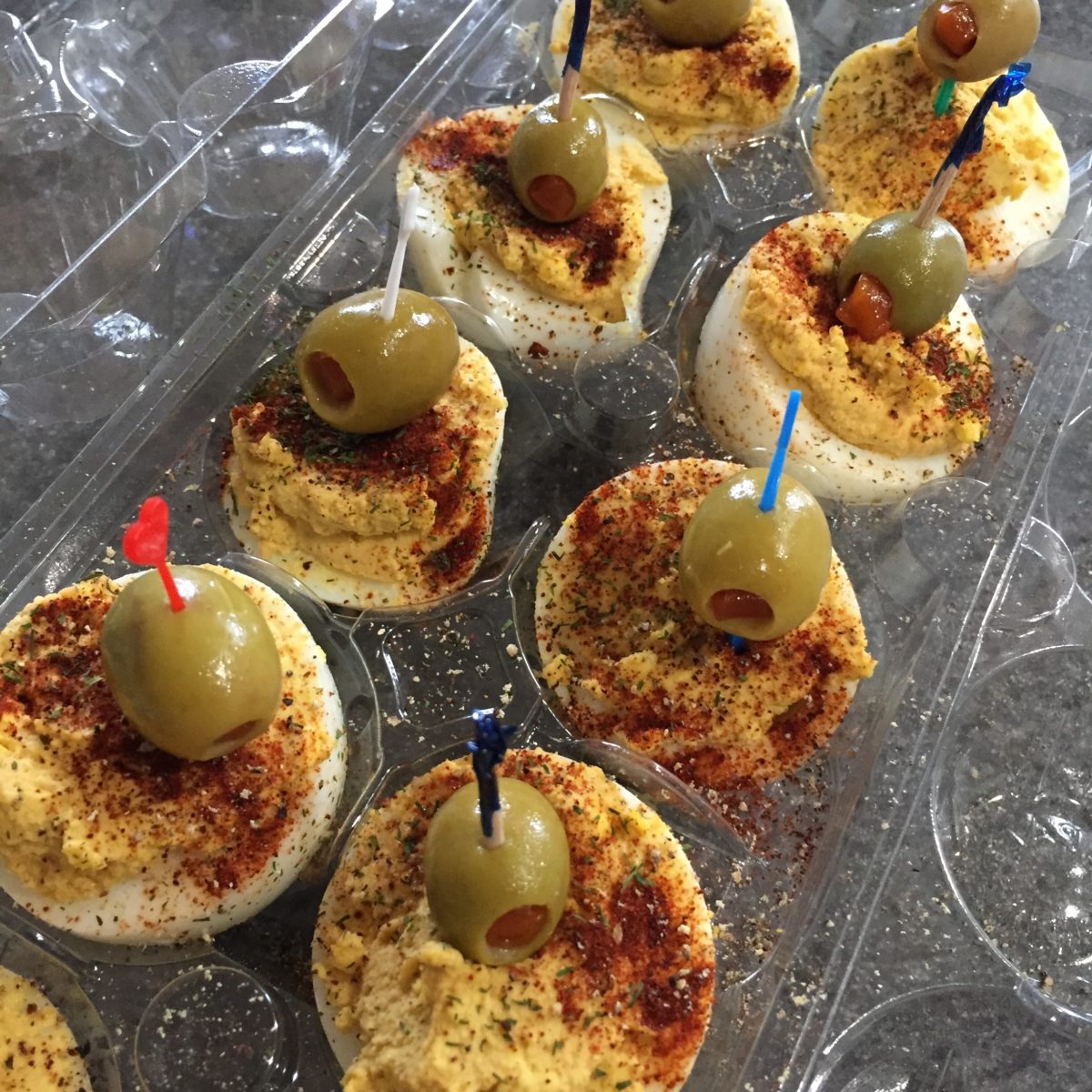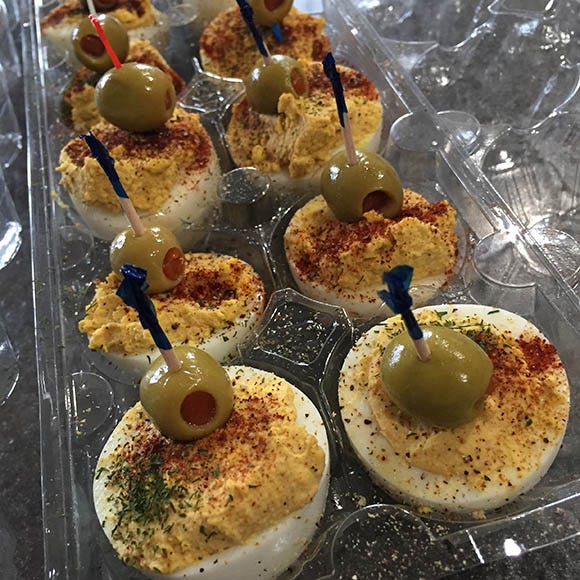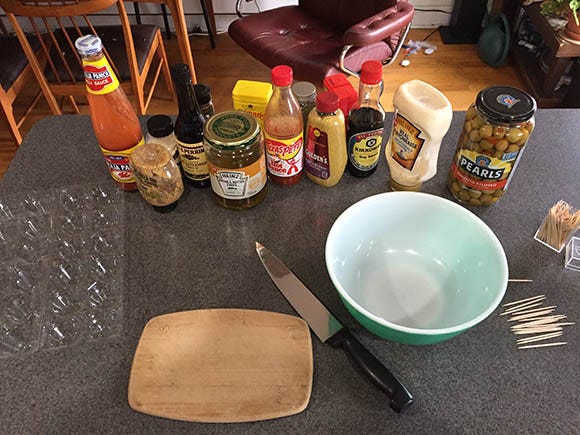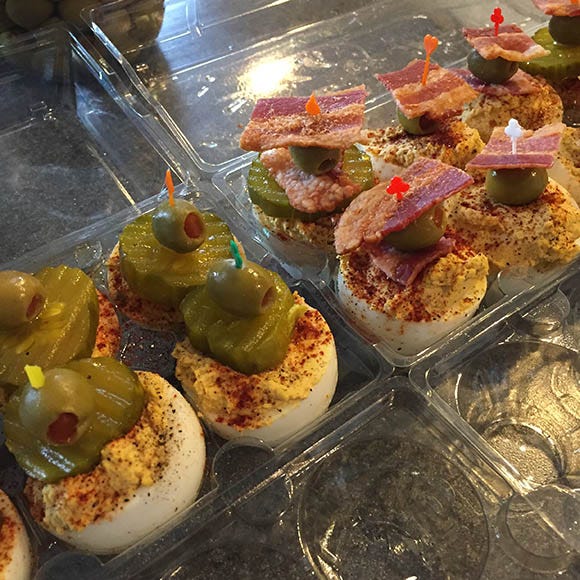
Originally posted January 29, 2019
THE SUPER BOWL is in Atlanta, where the Weather Underground app says it’s supposed to snowing with a low of 22 degrees on Tuesday, on the way to 58 degrees and raining for Super Bowl Sunday (the day after that is supposed to be 66 and still raining). None of these conditions apply to the game, which will be played indoors.
Why Are You Doing This
The Big Game Holiday is upon us, and I may or may not watch the Big Game (I keep hoping somebody will get Colin Kaepernick up on stage at halftime so he can tell the NFL to shove it some more), but what I will do for sure is eat potluck-style and drink with friends, and I like to blow everybody’s mind with crazy-savory, high-umami-content Deviled Eggs. There is nothing better with a cold beer than a super-savory high-protein high-fat-something that makes you want to drink more!
What is a Deviled Egg
In the United States of English, a half hard-boiled egg that has been stuffed with its own yolks, enhanced with other ingredients, is a “deviled egg,” one L. The United Kingdom uses two L’s. Personally I always think “de-viled eggs” looks odd when I write it, so I spell it D-E-V-I-L-L-E-D in the Crown’s English, and then hold an “L.”
It’s Not Really Cooking
I’m not a good cook, but when I was a kid I used to be good at making model airplanes, and eventually I found my way to the type of food preparation I’m good at, which is Assemblage, and the deviled egg, after the boiling part, requires nothing more than mixing and assembling. It’s really hard to screw up a deviled egg!
Most basic recipes for the filling or “batter” call for you to smash up the hard-cooked egg yolks with mayonnaise, some mustard, maybe a little pickle relish, then a coupla taps of paprika, maybe some dill weed, and if you’re feeling crazy, toothpick-skewer an olive into each dose for a garnish. If you’re stylish, use a mixer and turn that batter into a savory creamy substance, pack it into an icing cone and apply to the inside of your cooked egg-white halves. Fancy! Even if you just smash everything up with a fork and slap it into the egg-halves, it’ll be great, it’s made out of eggs and mayo!
If You Know How to Boil Water You Know How to Boil Eggs
OK, you are now fully checked out in deviled egg theory. Let’s boil some eggs! From years of experience, trial and error, etc., I have learned fresh eggs do not do well for this project if you boil them perfectly, like Martha Stewart, where you put the eggs in water, get it to just boiling, and then turn off the heat, cover, and wait 13 minutes. Martha Stewart never makes anything the easy way, even a boiled egg. You could look it up, but don’t bother. It’s a perfectly OK way to boil eggs, but I contend they will be delicate and sometimes difficult to peel. I have learned to keep eggs for at least a week, and on top of that, I have learned to boil the hell outta the eggs, get the water those eggs are sitting in to a good rolling boil, and then boil for at least ten minutes. Boil! Boil! If you’re going to make 12 servings, you boil six eggs, because you will be cutting them in half. If you want to be sure of your portion, add an egg in case you screw one up peeling or cutting. Plus that way there might be an extra serving or two for the cook to enjoy.
What I like to do is boil the eggs in a stock pot so I only have one layer of eggs sitting lengthwise. I have a theory that the yolks end up in weird spots if the eggs are crammed together and some of them are vertical, it might even be a superstition, but that’s how I do this. Science! OK, you have the eggs in a pot of water and there’s lots of water, not the one inch of water Martha Stewart wants, because we are going to boil these eggs beyond belief and we will lose water to steam. Deviled eggs are a good thing to make in winter climates when the heat is on and the house is dry! Lean over the pot for a free facial treatment!
Peel the Boiled Egg while Contemplating Buddha
When you are sure you have boiled the eggs a whole lot, take the pot over to the sink and dump the boiling-hot water out carefully, then set the pot in the sink and immediately fill it with cold water, which I think helps the eggs firm up and makes them easier to peel, or at least easier to handle while you’re peeling them, you don’t want to be peeling boiling-hot eggs, right? I watched the famous Nigella Lawson on her TV cooking show once and she talked about how she has “hands of stone” and can handle all kinds of hot things as she is cooking, but I think she just destroyed all the nerve endings in her hands to get that way. You have the hands of a surgeon! Get those eggs cooled off!
Keep the water running at a trickle. Smash an egg against the side of the pot or the sink to get it very cracked up and then hold the egg under the water as you peel the shell away, and you’ll get all the tiny annoying little pieces of shell off the egg. After you peel each egg, place it in a big bowl so the water runs off the eggs. Now you have a bowlful of eggs ready to cut in half!
There’s More than One Way to Bisect an Egg
Most of the deviled eggs you see in recipes are cut lengthwise, and you can do that if you are gonna serve them on a traditional egg-holding platter or carrying case. Yes, there are carrying cases made especially for deviled eggs. Some geniuses want to show you their improvised egg-carrying rigs, and that’s great, but the perfect egg-carrying case is the case the eggs came in when you bought ‘em, so what I do is slice the eggs horizontally and then put the halves back in the carton while I’m working. Any egg carton works. The clear plastic ones are the best for “wow factor,” but you might feel bad about plastic, and the paper ones are fine. Put some plastic wrap in there if you’re concerned about where the carton has been.

You need to be more careful to figure out where the yolk is sitting in the cooked egg, so find the sweet spot of each egg-white half so they will be able to hold some filling. It doesn’t have to be perfect, and if you end up with an egg-white half that’s not sufficiently concave, you can just scoop out a little bit of the egg white with a small spoon. Don’t worry if you split the egg white, it will be bound by the filling, and it only has to stay together for a few seconds after somebody lifts it up to their mouth.
More is More
What distinguishes killer deviled eggs is the presence of lots of stuff, wet and dry ingredients, in them and on them. Throw a little bit in, a little at a time, and keep tasting tiny bits of the batter and you’ll find your way. My way right now is I assemble all my wet and dry ingredients in front of me on the counter just within reach of my working area.
The working area is for:
- Cutting the eggs
- Getting the cooked yolks into a mixing bowl
- Placing cooked egg-whites into/onto the carrying case or platter
- Mixing the batter
- Spoon-filling the egg halves that are sitting in/on the carrying case or platter

Wet ingredients to add to the egg yolks:
- Mustard (a lot, I favor Gulden’s brown mustard but any spicy brown mustard will work)
- Mayonnaise (not very much)
- Soy sauce (a coupla ploops)
- Worcestershire sauce (a stripe or two across the bowl – omit for ovo-lacto “vegetarians” because of the anchovy)
- White horseradish – a little bit, be careful, it can overpower
- Texas Pete® hot sauce (high vinegar content, to taste, use whatever hot sauce you enjoy, and as much as you want, if you like to destroy the flavor and overpower it with a burning sensation that cancels out enjoyment of food in exchange for tickling your hot sauce-desensitized taste buds)
- Sriracha sauce (a little bit, maybe one or two stripes, depending on brand ingredients you might need to exclude for so-called “vegetarians” who eat eggs but don’t eat fish)
- Grainy mustard, the kind with the big whole mustard seeds visible (a tablespoon or two, mostly for appearance)
Wet Process
Once I have the cooked yolks in the bowl I dump in some brown mustard: several good full squirts if it’s a squeeze bottle, and two or three tablespoons if it’s out of a jar. Try not to think in tablespoons, though, simply be mindful of what you’re adding and how it’s affecting the mix. Add a bit at a time and be careful not to let it get too wet, you’re aiming for a stiff batter consistency, so add a little bit of mustard, then add mayo. I frequently make deviled eggs without mayo, but I guess the oil in the mayo helps make it smooth, if you are thinking you will be mixing the batter with a mixer and piping it into the egg halves. I just mash it all up with a fork.
The mustard and mayo are the largest amounts of wet you are adding, but the other things on my list are way more liquid-y, so add them sparingly and taste for effect. I always have a buncha toothpicks at hand to drag through the batter for many tiny tastes. You are building a pyramid of flavor! Once you’re happy with the batter go ahead and fill the egg halves, you’ll figure out how much, and you can always add more or take away to even it out, or just go randomly like I do because some people don’t want a giant pile of deviled egg, they just want a little bit.
Dry ingredients:
- Smoked paprika or Hungarian paprika, just not regular paprika, there’s a difference
- Chipotle chili powder
- Mustard powder
- Dill weed
- Black pepper
- Morton Season-All®, formerly McCormick Season-All (paprika, black pepper, onion and garlic, chili pepper. I use this so that I can add the tiniest bit of garlic and onion powder, because I have found I go overboard if I try to tap out straight garlic powder and onion powder)
Dry Process
Per egg, first, from the shaker top part of the container, one tap of mustard powder on top of each filled egg half. Tap, tap, tap, tap. If you’re not adding this stuff from a container with a shaker top, dump it into a bowl and do a small pinch from egg to egg, one small pinch. Then one tap of Season-All, one grind of black pepper or one shot out of a pepper shaker, one tap of chipotle chili powder, one tap of paprika, and then on top, one tap of dill weed. If you don’t like or have some of those ingredients, don’t worry, it’s still a deviled egg!
Garnishes
This is where you can go nuts. Pretty much anything can be a garnish. I’ve had deviled eggs with truffle fragments, caviar, sesame seeds, teensy pieces of fish or shredded brisket, you name it. If you can get it to stick to the egg or stay together on a toothpick, knock yourself out. I have settled down to pickle slices, green olives with pimento, and bacon fragments.
Lay out your toothpicks ahead of time so you’re not reaching into the toothpick container with wet fingers.

The relative wetness of each garnish dictates the order in which you will be skewering them onto the toothpick before you plant that toothpick straight up and down into the deviled egg. For example, if I’m using a piece of bacon and a slice of pickle and an olive, I skewer the bacon first, pretty far up the toothpick, then the olive, and then the pickle, so that when I’m driving the toothpick into the egg, I’m putting the wet pickle onto the wet egg surface, with the less-wet olive touching the pickle, and then the least wet bacon piece touching the olive. You don’t want to put something fun like a Cheetos or a tiny piece of melba toast onto the wet egg surface. You’ll figure it out, and even if you don’t, you have packed a tremendous amount of flavor entertainment into a tiny amount of space that takes one or two bites to destroy, and people will be too busy rolling their eyes in food-ecstasy to be worried that they got a wet Cheetos.
